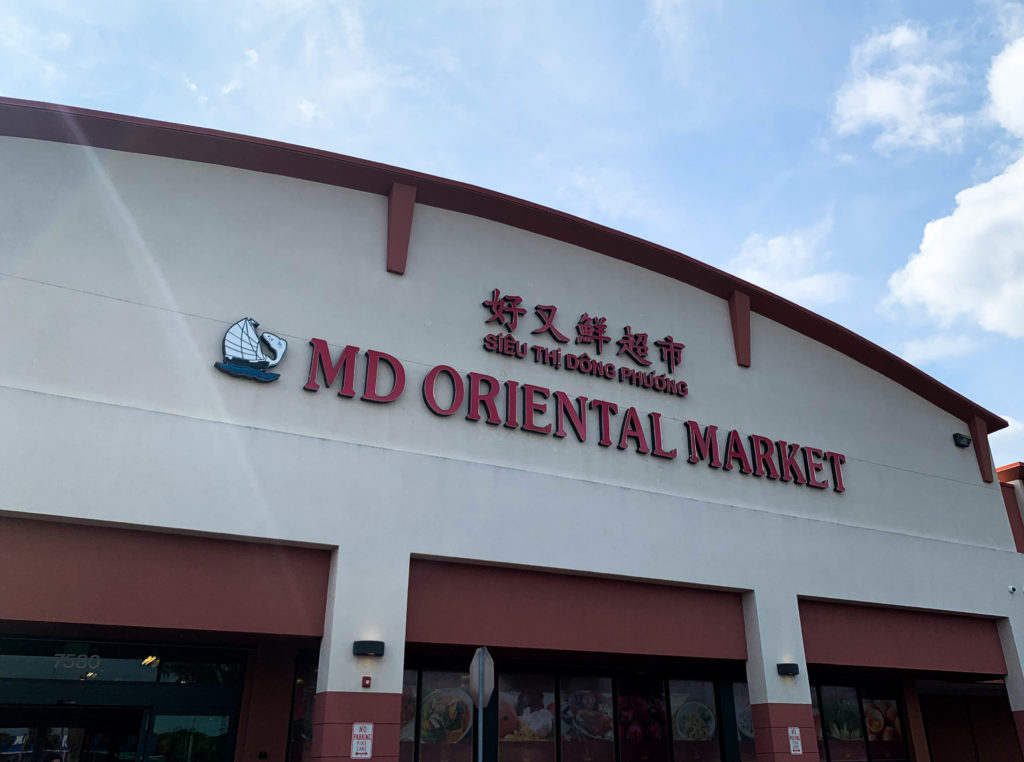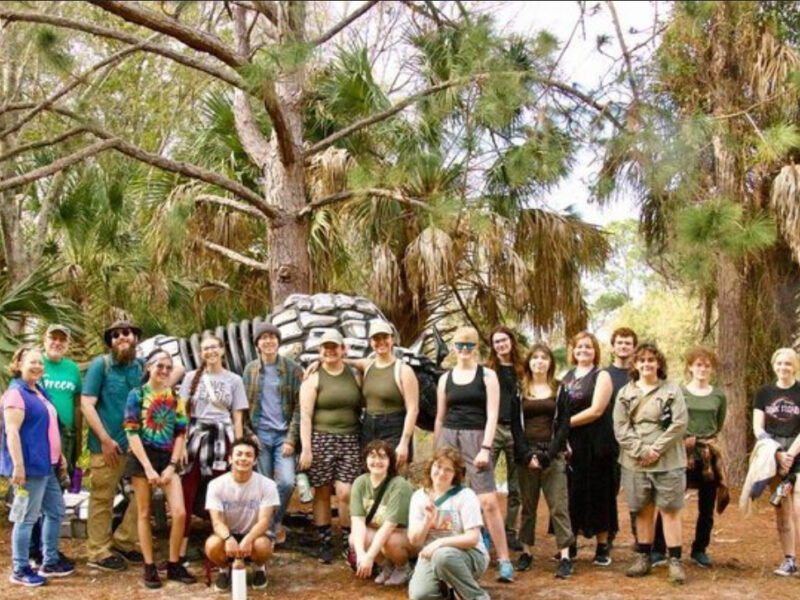
By Kyla Fields
You walk in and the first thing that hits you is the smell. Not necessarily bad, but it’s different.
And so familiar.
There’s fresh squid and octopus in one corner, imported spices that you’ve never heard of in the other. No one greets you or smiles at you when you walk in. You stroll up and down the shiny aisles of MD Oriental Market, and you see all types of different people.
People from different walks of life and different Asian ethnicities — although you might not be able to tell the difference — all shopping for possibly the most visceral connection to one’s culture: food.
It’s not your average grocery store. This market may seem like a strange and mysterious entity to some, but to Asians and Asian-Americans, an Oriental supermarket can be a second home.
That second home for many Asians in Tampa Bay is located off of U.S. Highway 19 in Pinellas Park.
The second thing one notices — whether they’re an Asian market veteran or amateur — is the sheer size of this grocery store, as it inhabits an old Publix building. Despite its large size, which is unusual, as traditional Asian groceries are small and family-owned, MD Oriental is a gem of St. Petersburg – hidden in plain sight.
But not everyone who shops at MD Oriental is Asian. On any day, it’s easy to observe that people from a wide variety of ages, ethnicities and backgrounds shop here.
The market offers a variety of fruits, vegetables, fresh meat, seafood and vegan options cheaper than Publix. Some people shop here because it’s a smarter economic choice, but it’s a supermarket option that many people may be unaware of.
A plethora of individuals can be found shopping at MD Oriental Market on a Saturday afternoon: a Vietnamese family with two small children in private school uniforms, a determined-looking white couple with a grocery list, and older, bickering Filipino couples alike take advantage of MD’s wide selection of Asian foods.
Aisles of noodles, rice, and a seemingly infinite amount of sauces (soy, eel, plum, you name it) fill the shelves of the grocery store.
Some navigate the aisles with confident, focused strides, while others meander around, waiting for a particular product to catch their eye. Not everyone who shops there is finding their second home. To some, it’s a travel adventure.
Two middle-aged white women stroll up and down the aisles of MD as they point to the bright packaging in the candy section.
They didn’t explicitly say they were from New York, but their Northeastern accents echoed off the linoleum floors of the supermarket, seemingly out of place. They weren’t shopping for groceries to cook dinner, but window-shopping of sorts in the Asian junk food aisle.
“I don’t even cook American food at my house, why would I try to cook Asian food?” Mary said. “We just had lunch at the Pho place at the end of the plaza. I wanted to show my friend how interesting this place is. We’re just looking at all of the cool snacks.”
“Interesting” to some, but “everyday” to others.
The Pho joint Mary was referring to is one of many Asian-owned businesses in the Pinellas Park area. Asian restaurants of different varieties – Thai, Vietnamese, Chinese, Japanese, Indian and other Oriental groceries populate the area of north St. Petersburg.
The growth of Asian businesses, restaurants, places of worship and supermarkets reflect the growth of Asian populations in metropolitan areas across the country.
Tampa Bay isn’t exempt from this population growth, as Asians and Pacific Islanders are the fastest growing immigrant group entering the United States, with the Asian population growing 72% since 2000, according to the Pew Research Center.
The staff of MD Oriental is comprised of almost all Asian immigrants. This supermarket gives individuals, who may struggle with English as a second language, a job in which they can speak their native language while contributing to the community.
There’s only one white person who works at MD: a produce stocker named Robert.
“Our American customers really appreciate Robert. People are always looking for someone who can answer their questions,” MD cashier Keely Changg said.
Changg, 23, is one of the only young people working at MD Oriental and has been a cashier for more than two years in the family business. Her father is one of the founders of MD Oriental Market, opening the first store in Tampa over a decade ago.
“After the first store on Fowler Avenue opened, Asian immigrants in Tampa could find the food and ingredients they grew up eating before moving to America,” Changg said while ringing up a customer.
Her father and his business partner “received a lot of positive feedback and support from the community and decided to open up another store in Pinellas Park,” she said.
“Along with Asian families, I see a lot of broke college kids buying ramen and anime fans shopping around, trying to be weebs. I just kind of roll my eyes at them,” she said, laughing. “A lot of people shop here for a lot of different reasons.”
In her personal essay for The New Yorker, Japanese Breakfast frontwoman Michelle Zauner talked about her different reasons for shopping at her favorite Oriental market. The food, atmosphere and smells of the market bring her to tears, as they remind her of her half-Asian identity and Korean mother and aunt, who both recently died of cancer.
“When I go to H-Mart, I’m not just on the hunt for cuttlefish and three bunches of scallions for a buck; I’m searching for their memory,” Zauner wrote.
“I’m collecting the evidence that the Korean half of my identity didn’t die when they did. In moments like this, H-Mart is the bridge that guides me away from the memories that haunt me, of chemo head and skeletal bodies and logging milligrams of hydrocodone.”
She is not the only Asian-American with emotional, cultural and familial ties to Asian supermarkets.
My mother immigrated to the United States from the Philippines in the mid-1990s, and I was born shortly after that. I grew up in the heart of the New Jersey Filipino community. All of my friends in high school were Vietnamese, and we took bi-weekly visits to Chinatown in Philly.
But I moved 1,000 miles away to St. Petersburg when I was 18 to attend college. My mother and I didn’t have a savory relationship at the time, and I suddenly found myself surrounded by people who did not look like me or my mom –– who were not Asian.
I had no idea my identity meant that much to me until I moved away from everything that reminded me of it.
I stumbled upon MD Oriental last year when I had to buy ingredients to make a sour Filipino stew called “Sinigang” for an online food podcast class I was taking. When I walked in, a wave of deja-vu hit me like a bus.
The smell was so familiar. Everything was so familiar. It took me back to when I would come home from school, open my front door and the smell of frying garlic would be so strong it would sting my eyes.
Or when my mom had to call my elementary school principal because two white girls in my class were making fun of me for smelling like the fried fish for my Lola that she cooked in the morning before she went to work.
It smelled like the hours I spent rolling “Lumpia” in the kitchen pretending to understand the Tagalog my titas were speaking far too loudly.
I felt all of this the second I walked through the doors of MD Oriental. Obviously, not everyone has this visceral and emotional of a reaction to a supermarket, but we all hold personal connections to the important places of our childhoods – however arbitrary they may be.
So you can understand why I hate when non-Asian people give MD Oriental Market a one-star review on Yelp because it smells like raw fish. That smell of raw fish brings tears to my eyes and makes me realize that it’s been too long since I’ve called my mother.




MD Market is an interesting place for valued cooked food, too. You can find West-coast style sushi, Taiwanese style bakery (when will they bring in portugal egg custard?), and to-go like Chinese food (of course).